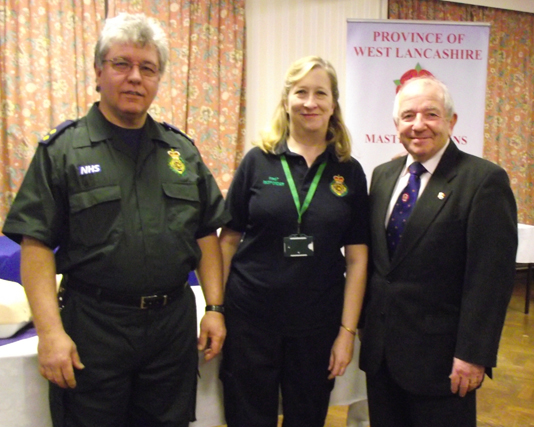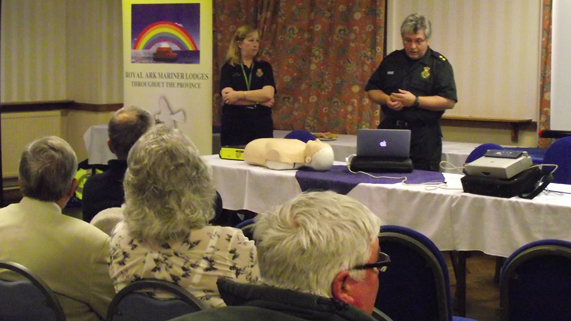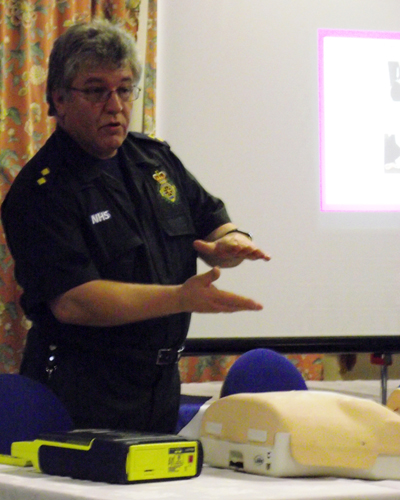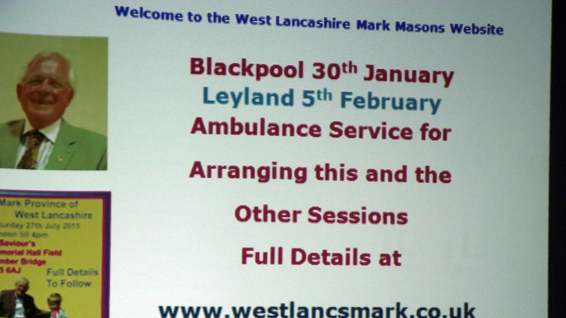Blackpool runs further course on defibrillator |
|
| The roll out of defibrillators provided by Mark Masonry continues apace throughout the Province of West Lancashire and Masons meeting at Adelaide Street Masonic Hall, Blackpool, as well as quite a few of their ladies, took advantage of an information session where they were welcomed by Deputy Provincial Grand Master Keith Beardmore. | |
 |
|
Ian and Carolyn Mullineaux are welcomed to Blackpool by Keith Beardmore. |
|
| John Forster the PrGM’s Special Representative for the Fylde had arranged the session for ‘seasiders’ who had missed the previous presentations and others who wanted a refresher course. | |
| Keith advised his audience that some 23 defibrillators have been introduced to Masonic halls throughout the Province, in some cases two machines due to the size of the hall, since the launch of the programme at Cleveleys Masonic hall. Previously the vital machines had not been available. | |
 |
|
Carolyn and Ian explain the life saving potential of defibrillators. |
|
| Keith drew laughter from the attendees when he remarked that: “Most of us are in that kind of age group where the defibrillators are of most benefit.” | |
| Although Keith has participated in previous training sessions and has been put through his paces trying out the life saving machines himself, he left the presentation to the professionals, Carolyn Mullineaux and her husband Ian. | |
| Ian is training coordinator for the North West Ambulance service, a medical team inspector for the Fylde and a first responder. Carolyn is a group community first responder. | |
 |
|
Ian emphasises how compact the defibrillator is. |
|
| Ian told his audience that with something in the order of 60,000 cardiac arrests happening in the UK every year defibrillators were playing an increasingly vital role in boosting survival rates. He stressed that though they were a tremendous first aid in the chain of survival, increasing survival chances by up to 75%, it was also as important to dial 999 to alert the emergency services. | |
| He said that as every minute from the start of administering CPR increases the chances of a heart attack victim recovering, estimated at around 10% per minute, it was extremely important to begin CPR as early as possible before the emergency services arrived. | |
| He outlined the differences between a suspected cardiac arrest and the signs to look for; no heart beat or signs of breathing, and a heart attack which manifests such signs as chest or back pain, irregular or laboured breathing and pale or clammy skin pallor among others. | |
 |
|
The Mark website power point presentation gets the message across. |
|
| Demonstrating the defibrillator he showed how the machine gives automated step by step verbal instructions to the user from the moment it is activated. Once pads are affixed to the chest – as instructed by the machine – it analyses the condition of the patient and either instructs the user to begin heart massage (CPR) usually 30 compressions followed by mouth to mouth resuscitation, or takes the initiative to deliver an electric pulse to the patient. Contrary to popular belief Ian apprised his audience this electric shock actually stops the heart so that it goes on, hopefully, to ‘reboot’ itself naturally. | |
| Ian took his audience step by step through the defibrillator procedures and also spoke of some real life cases he had and Carolyn had been involved in. He also gave some helpful hints on safety at the scene of an incident, maintaining the dignity of the patient, particularly where the heart attack victim is female, and the importance making sure that the 999 call has been made. | |
| He added that the availability of defibrillators was becoming more and more common in public buildings and places of work because of the recognition of their life saving capabilities and that every Masonic hall should advise their local ambulance authorities that they had a defibrillator on site. | |
| Keith thanked Ian and Carolyn at the end of their presentation for taking the time to come to Blackpool Masonic Hall and for the riveting and invaluable insight they had given on the use of defibrillators. | |
| Article and Photographs by Bob Boal | |
| Presentation by Giles Berkley | |
| Defibs Courtesy of WEST LANCS MARK MASONS | |
